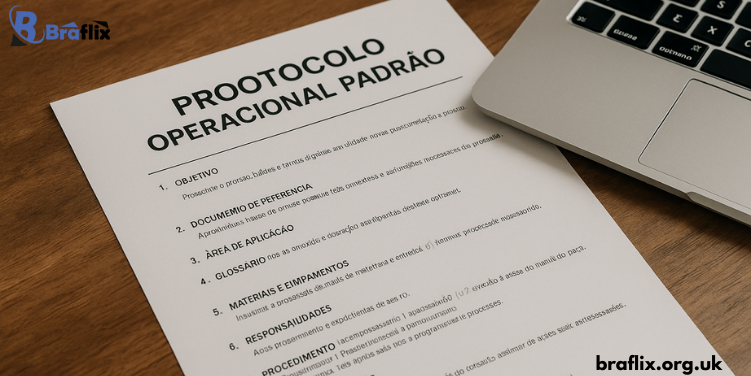Introduction
In every organization, whether in healthcare, industry, logistics, food production, or information technology, consistency is key. To achieve uniformity and maintain quality, businesses rely on Standard Operating Procedures (SOPs), known in Portuguese as Protocolo Operacional Padrão (POP).
A POP is a formal document that defines the exact steps to carry out a specific task, ensuring that all employees follow the same standards. This makes processes more efficient, reduces risks, and guarantees compliance with industry regulations. In today’s competitive and regulated environment, having well-designed SOPs is not just useful—it’s essential.
What Is a Protocolo Operacional Padrão (POP)?
The Protocolo Operacional Padrão is a structured guide that provides clear, step-by-step instructions for performing recurring organizational tasks. It covers not only how the task should be done but also who is responsible, what resources are needed, and what safety measures must be followed.
In simple terms, it is a blueprint for routine work. For example:
- In healthcare: instructions for preparing medication or sanitizing equipment.
- In manufacturing: detailed machine operation and maintenance routines.
- In food services: hygiene and food-handling procedures.
By using a POP, organizations ensure that the same procedure is followed every time, regardless of who executes it.
Also Read: Tribe HR Team: Building Agile and Collaborative Human Resource Structures
Why SOPs (POPs) Are Important
Implementing SOPs brings multiple benefits:
- Standardization – Ensures tasks are performed in a consistent manner.
- Efficiency – Reduces errors, rework, and wasted resources.
- Quality Control – Maintains high standards and improves customer satisfaction.
- Training and Onboarding – Provides a practical guide for new employees.
- Legal and Regulatory Compliance – Critical in industries like healthcare, pharmaceuticals, and food processing, where mistakes can have serious consequences.
For example, in a hospital, having a POP for sterilization of surgical tools ensures patient safety and compliance with medical regulations.
Core Elements of a Protocolo Operacional Padrão
A well-designed POP generally includes:
- Title: The name of the procedure.
- Objective: Why the SOP is necessary.
- Scope of Application: Where and when it applies.
- Responsibilities: Who is accountable for execution.
- Required Materials: Tools, equipment, or resources needed.
- Step-by-Step Procedure: Clear, sequential instructions.
- Quality and Safety Measures: Standards and risks to watch for.
- Date and Revision: To ensure continuous improvement and updates.
Step-by-Step Guide: How to Create an Effective POP
If you want to implement a Protocolo Operacional Padrão in your organization, follow these steps:
Step 1: Identify the Process
Choose a task that is critical, repetitive, or requires regulation (e.g., food handling, machine operation).
Step 2: Define the Objective
Clearly explain the purpose of the procedure and the result expected.
Step 3: Gather Information
Interview employees who perform the task daily to ensure accuracy and practicality.
Step 4: Write the Document
Use simple language, short sentences, and imperative verbs (“Check,” “Record,” “Clean”). Avoid ambiguity.
Step 5: Test the SOP
Have different employees follow the POP to confirm it works in real conditions.
Step 6: Train Employees
Introduce the SOP to the team, making sure everyone understands and follows it.
Step 7: Review Regularly
Update the POP whenever processes, technology, or regulations change.
Tip: Keep the document accessible—post it in work areas or store it in a shared digital folder.
Challenges in Implementing SOPs
Even though POPs are extremely useful, organizations often face obstacles such as:
- Resistance to Change: Employees may prefer old habits.
- Overly Complex Language: Too much jargon makes the SOP confusing.
- Lack of Updates: Outdated procedures reduce efficiency and may cause risks.
The solution is to involve employees in the creation process, keep the language simple, and schedule regular reviews.
Also Read: PO Box 7472 Bilston: Understanding Its Purpose and Relevance
Conclusion
The Protocolo Operacional Padrão (POP), or Standard Operating Procedure (SOP), is a cornerstone of organizational success. By providing structured, step-by-step instructions, it helps businesses maintain efficiency, quality, safety, and compliance across all departments.
Whether in healthcare, food service, manufacturing, or IT, SOPs ensure that tasks are executed consistently, minimizing risks and maximizing productivity. Implementing well-designed POPs is not just about documentation—it’s about creating a culture of discipline, safety, and continuous improvement.
Frequently Asked Questions (FAQs)
1. What does Protocolo Operacional Padrão (POP) mean?
It is the Portuguese term for Standard Operating Procedure (SOP), a formal document describing how to perform tasks step by step.
2. Why are POPs important?
They ensure standardization, improve efficiency, reduce risks, and help organizations comply with legal and safety standards.
3. Who should write a POP?
Usually managers, supervisors, or process experts, with input from employees who perform the task daily.
4. How often should a POP be updated?
It should be reviewed regularly—at least once a year or whenever processes or regulations change.
5. Are POPs only for large organizations?
No. Even small businesses benefit from SOPs by ensuring quality and efficiency in daily operations.





























